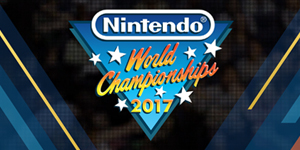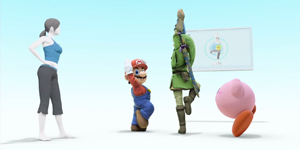Extra: The Games and Sights of IndieCade 2013
Indie games are kind of a big deal. Thanks to download services, crowdfunding platforms, and numerous breakout hits, the indie scene has seen huge growth in the past few years. Nothing demonstrates this better than IndieCade, the International Festival of Independent Games that is often called “the video game industry’s Sundance.” What started as a small showcase of indie games in Bellevue, WA seven years ago has expanded into an event sprawled across downtown Culver City, CA that draws the industry’s biggest names, including Sony, Microsoft, and yes, even Nintendo. We spent this past weekend taking in all the sights (which you can find in the gallery below) and playing a robust lineup of indie titles for Wii U and 3DS.
Unlike more traditional expos such as E3 and Comic-Con, IndieCade is not housed in a giant convention center. Instead, the festival takes place in numerous locations in Culver City, including a fire station garage and a block-long parking lot that is transformed into a strip of tents and temporary structures. For Nintendo’s first trip to IndieCade, they decided to go big – both literally with the largest booth of any IndieCade exhibitor, and figuratively with a total of seventeen different game demos. The demos were divided between Nintendo’s two adjoining tents. One tent was crammed with eleven Wii U kiosks that each offered a different title to try, while the other tent provided a more laid back lounge for demoing six different 3DS titles. The selection was so vast that it was honestly a bit overwhelming at first.

The games that stuck with us the most were those that offered the most unique experiences. Perhaps one of the best games at Nintendo’s booth was Armillo, a title that combines the spherical stages of Super Mario Galaxy with a character who handles like Sonic in a perpetual spin dash. Developer Fuzzy Wuzzy Games was on hand with a three-stage demo, which showed off the game’s fast-paced blend of action and light puzzle solving, the ability to arm the titular Armillo with different power-ups, and a multi-part boss battle. Armillo won’t be out until early 2014, but it’s definitely one to watch. Equally fast paced, but strictly on a 2D plane, was Scram Kitty and his Buddy on Rails. Also for Wii U, this is an on-rails shooter played from the top down, in which players can only move on set tracks as they shoot enemies and grab items. There are multiple tracks per stage, and players can jump between them if they build up enough momentum and launch at just the right angle. It’s like hopping between planets in Mario Galaxy, but in 2D.
Balancing out the speed and insanity of Armillo and Scram Kitty were two other unique Wii U experiences. The most methodical and relaxing was Tengami, a side-scrolling, point-and-click adventure that takes place in a world made entirely out of rice paper. The demo tasked us with completing a series of puzzles to progress from one stage to the next, but it was hard to not be distracted by the stunning visuals. Tengami is entirely controlled through the GamePad’s touch screen and every action we took utilized the virtual rice paper in a way that mimics the real world. In fact, the entire game’s rice paper usage is to true to real life. Q.U.B.E: Director’s Cut is another experience that is grounded in one particular aspect of reality: physics. As in the original version of the game, the Wii U enhanced port sends players through a series of sterile white rooms, manipulating blocks in the environment to solve puzzles. The game feels a lot like Portal, right down to the first-person perspective, physics-based gameplay, and the use of only two buttons to control opposite actions (in this case, pushing and pulling blocks instead of creating the two sides of a portal).

On 3DS, the unique experiences also came in frantic and calm varieties. On the frantic side was the 3DS port of Retro City Rampage, an ode to the pop culture of the 80s and present that plays out like an 8-bit Grand Theft Auto. In the brief time we spent with the game, we saw references to everything from The Dark Knight’s bank heist scene to Back to the Future’s Doc Brown to even Doctor Who. The only disappointment was that the game did not support the 3D display, but this was apparently done to ensure a timely release. Attendees who preferred a more calming experience could give the just-announced Siesta Fiesta a try. It plays like a mashup of Brick Breaker and Wii title FlingSmash, replacing the Brick Breaker paddle with a bed and the ball with a person sleeping in the fetal position. The goal? To smash said sleeping person into the bricks hovering above as the level auto-scrolls from left to right. It was possibly the strangest thing we played at IndieCade, but also surprisingly fun in its simplicity.
As we sampled the other games at Nintendo’s booth, we soon realized that they fell into one of two distinct categories: traditional platformers and old-school RPGs. On Wii U, the platformers were strictly side-scrollers. The one that drew the biggest crowd was Kickstater darling Shovel Knight, an 8-bit throwback that puts players in the shoes of a knight armed with, you guessed it, a shovel. The developers at Yacht Club Games absolutely nailed the retro aesthetic, from the handling of the knight’s Ducktales-style downward shovel thrust to having the character overlap the HUD when at the top of screen. Cut from a similar retro cloth was 1001 Spikes, the next title from Cave Story publisher Nicalis. We initially played this 8-bit title at Anime Expo in June (check out our full impressions in Episode 48 of the podcast) and it offered an equally fun yet challenging experience during this second go-round, requiring us to time every jump and half-jump just right so we wouldn’t die at the hands of spike, pit, or trap.

While retro was certainly in at Nintendo’s IndieCade booth, some developers chose other styles for their Wii U platformers. Neko Entertainment presented a “Japan Steam Rock” world in Wooden Sen’SeY, a 3D rendered side-scroller that arms players with a versatile set of axes to slice, grapple, and double-jump through stages. The game begins with a feudal Japan art style, featuring lots of bamboo and stones, before slowly transitioning into more metal and mechanical environments. For those who may prefer steampunk to “steam rock,” Teslagrad from Rain AS was also on display for attendees to sample its electromagnetic-themed puzzles. The open world platformer features gorgeous hand-drawn art that bares a resemblance to Professor Layton, which ends up being a logical fit as the game is also set in Europe and skews towards puzzles over action. Lastly for Wii U platformers, the inexplicably M-rated Knytt Underground challenged attendees to progress through silhouetted side-scrolling rooms, each of which required using the game’s mechanics in a different way to navigate across. Oh, and one of those mechanics just so happened to be the ability to turn into a bouncy ball. Yes, a bouncy ball.
The 3DS also had a healthy number of platformers on display, all of which were from developers who previously cut their teeth on Nintendo platforms. WayForward brought a demo of Shantae and the Pirate’s Curse, the first 3DS adventure for its belly-dancing heroine. The game felt true to previous entries in the series with a Metroidvania structure in which Shantae explores levels, fights bosses, and whips her hair aplenty. It’s familiar yet fun ground for Shantae fans, but now with the added bonus of layered backgrounds in 3D. Renegade Kid’s Treasurenauts also used the 3D effect to present a layered effect for its side-scrolling world, but was an overall bigger departure from its own predecessor, Mutant Mudds. The new game puts less emphasis on simply platforming towards a level goal, instead focusing on the collection of all the treasure in each stage. The challenge comes from the enemies and bosses you encounter along the way. As we learned the hard way, getting hit by an enemy makes all your collected gems and jewels go flying out of you, Sonic The Hedgehog style. The one platformer at Nintendo’s booth that broke the side-scrolling mold was Jett Rocket II: The Wrath of Taikai from the tech wizards at Shin’en. This sequel to the WiiWare original takes advantage of the 3DS’s extra capabilities to present a fully rendered, 3D world that felt reminiscent of Super Mario 3D Land, providing a free range of motion within limited spaces.

Bridging the gap between the platformers and the RPGs at Nintendo’s booth was Unepic, a side-scrolling adventure for Wii U that sends players through a 200-room tower. While the demo obviously didn’t feature all 200 rooms, it did offer plenty of real-time battles that required strategically choosing which of the game’s 100 weapons and 70 spells to use again specific enemies. More traditional RPGs were on display, too. For 3DS, this came in the form of Grinsia, an ode to 16-bit RPGs that includes an “EX Skills” system in which the items you carry grant different abilities. The title felt as retro as could be, right down to the dialog box designs and chiptune soundtrack (a new addition exclusive to the 3DS version). If attendees preferred to play a retro RPG that was previously on an actual retro console, that was available as well. The developer of Sega Genesis homebrew title Pier Solar and the Great Architects was on hand to demo the upcoming Wii U edition. While it was admittedly hard to get a sense of how the entire 50-hour adventure will play out from a brief demo, we could immediately tell that the game successfully emulates the feel of classic 90s RPGs.
In addition to the many game demos, Nintendo’s booth contained a kiosk explaining free developer tools such as the Nintendo Web Framework and Unity Engine. Plus, they were giving out free shirts that proved to be quite popular – you can find a photo in the gallery below. But what was going on beyond the walls of Nintendo’s tent? A lot, actually. Other exhibitors included Oculus VR with their virtual reality Oculus Rift headset, Sony with playable PlayStation 4 demos, and Ouya with its $99 Android game console. Exhibitors are only a part of IndieCade, though. The meat of festival is a series of events that include lectures, learning sessions, live music, tabletop games, an award ceremony (Wii U title Spin The Bottle: Bumpie’s Party was even nominated), and an annual tradition known as Night Games. The latter is particularly interesting as it lets developers create avant-garde experiences based around gestures, movement, and the environment surrounding players. For example, one game at this year’s Night Games had players navigate a laser maze to pull off a heist, while another required players to dance/spar while wearing an assortment of sensors that measured who was winning the bout.

IndieCade is an experience like no other and well worth checking out if you are in the Los Angeles area when it returns in 2014. It’s the one event that celebrates small-time developers, the teams of three working out of a garage and the individuals who stay up coding until 3 AM. It’s the event where Nintendo publicly turns its attention away from its Marios and Zeldas for just a few days to shine a light on the next great eShop games that will bring us new characters, new ideas, and new experiences. At this year’s event, we were able to meet a space-faring armadillo, a knight armed with only a shovel, and a boy who transforms into a ball. We can’t wait to see what next year brings.
The Sights:
Want more IndieCade coverage? Check out Episode 54 for additional impressions!























